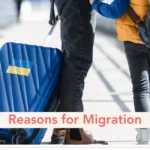2025 Australian Skilled Migration: Latest Updates & Eligibility Checklist
Introduction
Australia’s skilled migration program for 2025 remains a cornerstone of its economic growth strategy, with the government allocating 185,000 places for new migrants, including 132,200 specifically for the skill stream—representing over 71% of the total intake. These updated figures reflect the country’s evolving workforce needs, offering specialized visa pathways and occupation lists that respond directly to current labor shortages, especially in healthcare, technology, and education sectors.
What is Australian Skilled Migration in 2025?
Australian skilled migration refers to the process by which qualified professionals from around the world move to Australia to fill gaps in the workforce. Applicants are assessed based on their qualifications, professional experience, and alignment with the country’s Core Skills Occupation List (CSOL) for 2025. Successful candidates can secure work visas that can lead to permanent residency, family opportunities, and access to Australia’s high quality of life.
Latest 2025 Migration Program Announcements
In September 2025, Australia confirmed its migration program intake remains at 185,000 places for 2025-26, with the skill stream firmly prioritized to match ongoing talent shortages. The remaining 52,500 places form the family stream, targeting reunification and long-term settlement, while a small allocation is set for special eligibility cases.
Key highlights for this year’s skilled migration program include:
- The introduction of the Skills in Demand Visa, designed to match applicant skills to acute labor shortages in healthcare, software engineering, and renewable energy.
- National Innovation Visa: Replacing several older categories to simplify the process for professionals in STEM, research, and emerging fields.
- A recalibrated Core Skills Occupation List (CSOL), which identifies critical occupations for the Australian economy, dynamically updated in 2025 to better reflect market realities.
Current government policy closely tracks national labor market data to ensure each stream addresses specific gaps and priorities. Regional nomination programs offer additional migration pathways for candidates willing to settle outside major cities, increasing opportunities in key professions.
Skill Stream Breakdown: What’s New?
2025 brings a major overhaul to Australia’s skilled migration pathways, ensuring that applicants and employers benefit from a streamlined system that better responds to shifting national needs. Two significant programs lead the way:
- National Innovation Visa: An all-new stream for those with strong backgrounds in science, tech, engineering, and advanced trades, focused on start-ups, research, and high-impact sectors. This change helps Australia attract global talent, particularly in the fields shaping the future economy.
- Skills in Demand Visa: Focusing on immediate workforce needs, this category allows applicants whose occupations appear on the CSOL to access a faster, simplified application process. In-demand jobs include primary healthcare professionals, teachers in STEM subjects, energy sector specialists, and critical infrastructure managers.
Tip for Applicants:
Review the latest CSOL and government announcements regularly; the list of eligible jobs now updates quarterly in 2025, so timing can directly impact application outcomes.
Updated Occupation Lists in 2025
The newly-released Core Skills Occupation List (CSOL) replaces older schemes like the PMSOL, offering a more dynamic review of what jobs are “in shortage” and eligible for migration. For 2025, Australia continues to prioritize sectors that address major skills gaps and support national recovery and growth.
Key sectors dominating the CSOL in 2025:
- Healthcare (doctors, nurses, allied health)
- Technology (developers, cybersecurity, data scientists)
- Education (teachers, training specialists, curriculum designers)
- Renewable energy (engineers, technicians)
List of high-priority occupations for 2025:
- Registered Nurses
- Systems Analysts
- Secondary School Teachers (STEM)
- Renewable Energy Engineers
- Aged Care Workers
By continually refining this occupation list, the government ensures that skilled visa holders create the greatest impact. Regular updates mean applicants must monitor official channels to confirm their eligibility and prepare necessary documentation accurately.
Eligibility Checklist: Step-by-Step
Navigating skilled migration requires a precise approach. Here’s a direct checklist for 2025:
- Confirm occupation on the CSOL
- Age: Must be under 45 at the time of application.
- English proficiency: Minimum score of IELTS 6.0 (or equivalent).
- Skills assessment: Have qualifications recognized by the relevant Australian authority.
- Work experience: At least 2 years in the nominated profession.
- Points calculation: Achieve a minimum pass mark (currently 65 points) based on factors like education, professional background, age, English, and partner skills.
- Health and character checks: Ensure compliance with national standards.
Applicant Tip:
Gather all documents in advance, including transcripts, professional certificates, and proof of English skills. Ensure that qualifications align precisely with the CSOL entry to avoid unnecessary delays.
Case Studies & Real User Reviews (Reddit/Forums)
Many applicants turn to communities like Reddit for honest feedback and support throughout the skilled migration process. Real user experiences from 2025 highlight several key takeaways:
- “Got state nomination for software jobs much faster than expected—definitely worth watching quarterly updates!”
- “Document authenticity is always scrutinized, so triple-check everything before submitting.”
- “Family inclusion worked seamlessly with partner’s eligibility—joint applications seem to get processed efficiently.”
- “Delays in skills assessment caused problems for me—start with that step early.”
Common challenges include:
- Navigating unpredictable occupation list changes.
- Maintaining clear communication with migration authorities.
- Managing timelines amid evolving regulation.
Tips from successful applicants:
- Use multiple official sources for occupation list verification.
- Join migration forums for peer support; real-time Q&A helps, especially around documentation.
- Seek expert advice before major deadlines or regulatory updates.
By learning from others’ experiences, new applicants can anticipate problems and optimize their migration strategy for Australia in 2025.
Regional and State-based Opportunities
Australian skilled migrants have a growing array of choices outside major capital cities, as regional pathways become a key focus in 2025. According to the Regional Movers Index, migration from urban centers to regional Australia increased by 10.5% in early 2025, with more than 10 million people now residing outside metro areas.
State and territory nomination schemes target in-demand professions such as registered nurses, engineers, teachers, and aged care workers. The Skilled Employer Sponsored Regional (494) visa enables regional employers to sponsor overseas talent to fill workforce gaps directly. Regional programs also offer additional points and faster approval timelines for eligible applicants.
Australian skilled migration in 2025 includes distinct regional and state nomination streams, allowing migrants in healthcare, technology, and education sectors to access extra opportunities and incentives if they choose to live and work outside major cities.
Policy Changes Impacting Employers and Sponsorship
Employer-sponsored visas remain central to the Australian migration strategy. In 2025, 44,000 employer-sponsored places are allocated, with stronger compliance requirements to ensure genuine skill shortages are filled. Recent reforms require sponsors to demonstrate the necessity for overseas hires and follow enhanced labor market testing guidelines.
Businesses benefit from greater clarity and stable program structures, helping them plan recruitment confidently. Sectors such as healthcare, construction, and technology are top beneficiaries due to chronic workforce shortages.
Employer Sponsorship Tips:
- Conduct early role eligibility checks.
- Prepare documentation supporting the need for overseas recruitment.
- Monitor quarterly occupation list updates to optimize candidate selection and nomination timelines.
Citizenship, Settlement & Long-Term Outcomes
Once granted, skilled migrants enjoy high rates of settlement success in Australia. The latest ABS data shows that 85% of skilled migrants secure full-time positions within the first year, and over 90% express satisfaction with local healthcare and education services. About 60% obtain citizenship within four years—a testament to the integration pathways provided.
Migrant families benefit from streamlined PR options, comprehensive settlement support, and access to Australia’s thriving housing and social infrastructure. Initiatives to curb “city-centric” settlement encourage migrants to move into regional communities, boosting local economies.mia+1
Settlement Support List:
- Local orientation programs
- Career counseling and language assistance
- Healthcare registration guidance
- Regional relocation grants for select applicants
Pros & Cons Table
| Visa Type | Main Advantages | Drawbacks | Key Requirements |
|---|---|---|---|
| Skilled Independent (189) | High freedom, PR on arrival | Strict points cutoff | Skills assessment, 65+ pts |
| Employer Sponsored (186/494) | Job assurance, priority process | Needs employer support | Employer nomination, job offer |
| State/Territory Nominated (190/491) | Regional bonus points | Must live in sponsored state | State nomination, CSOL match |
Frequently Asked Questions (FAQ)
Who is eligible for the Skills in Demand visa?
Applicants with occupations on the current CSOL, relevant qualifications and English proficiency.
Which jobs are on the 2025 Core Skills Occupation List?
Healthcare, technology, engineering, education, and renewable energy professionals.
How can family members migrate with skilled applicants?
Applicants may include spouses and dependent children in their applications; joint eligibility often accelerates processing.
What English proficiency is required in 2025?
A minimum IELTS score of 6.0 or equivalent is standard.
How long does processing take for skilled migration?
Most applications process within 6–9 months, but timelines vary by visa type and occupation.
Research Spotlight: Evidence for/Against Skilled Migration Policies
Australia’s skilled migration policies are widely credited with boosting productivity, workforce participation, and long-term fiscal health. For instance, research by the Grattan Institute confirms that skilled migrants have higher lifetime contributions and fill vital gaps that locals cannot meet quickly. The 2025 Migration Strategy aims to strengthen these outcomes by matching migrants to actual market needs, improving skill recognition, and limiting exploitation or underemployment.
However, critics highlight potential downsides, such as regional disparities and pressure on housing. Policy responses, including revised occupation lists and stricter employer checks, target these gaps proactively. On balance, skilled migration remains central to Australia’s growth, with data showing net positives in social and economic metrics.
Conclusion
In summary, Australia’s 2025 skilled migration program stands as a robust, data-driven solution to the country’s workforce and demographic challenges. With a permanent intake cap of 185,000 and 71% reserved for skills-based immigration, the government addresses both economic and regional needs through new visa categories, evolving occupation lists, and transparent eligibility frameworks. Applicants benefit from stable employer-sponsored programs, detailed nomination schemes, and comprehensive settlement support designed for enduring integration.
Key updates—such as the quarterly review of the Core Skills Occupation List and reforms to employer sponsorship requirements—ensure that both applicants and local communities thrive. Settlement data, regional incentives, and nuanced policy reforms work together to guarantee positive long-term outcomes for migrants and Australia alike.
For skilled applicants, following the eligibility checklist and seeking expert guidance can fast-track migration success. The enduring appeal of Australia’s high quality of life, employment security, and family-friendly policies makes it a world-leading destination for global talent in 2025 and beyond.








